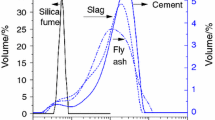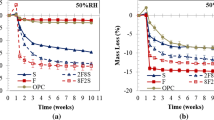Abstract
Considering the different hydration processes of concrete without accelerator, sprayed concrete with low-alkali accelerator not only presents short setting times and high early-age mechanical properties but also yields different hydration products. This study presents an analysis of the mechanical properties of concrete with and without accelerator and sprayed concrete with three water–binder (w/b) ratios and four dosages of fly ash (FA) after different curing ages. It also examines the setting time, mineral composition, thermogravimetric–differential scanning calorimetry curves and microscopic images of cement pastes with different accelerator amounts. Furthermore, the setting time and microstructure of accelerated sprayed concrete with different w/b ratios and FA contents are examined. Results show that the retarded action of gypsum disappears in the accelerated cement–accelerator–water system. C3A is quickly hydrated to form calcium aluminate hydrate (CAH) crystals, and a mesh structure is formed by ettringite, albite and CAH. A large amount of hydration heat improves the hydration rate of the cement clinker mineral and the resulting density, thereby improving mechanical properties at early curing ages. The setting times of the pastes increase with increasing w/b ratio and FA dosage. Thus, the hydration level, microstructure and morphology of the hydration products also change. Models of mechanical properties as functions of w/b, FA and curing age, as well as the relationship between compressive strength and splitting tensile strength, are established.













Similar content being viewed by others
References
Thomas A (2012) Sprayed concrete lined tunnel. Taylor and Francis, New York
Hemphill GB (2013) Practical tunnel construction. Wiley, Hoboken
Won J-P, Hwang U-J, Kim C-K, Lee S-J (2013) Mechanical performance of shotcrete made with a high-strength cement-based mineral accelerator. Concr Build Mater 2013(49):175–183
Prudêncio LR Jr (1998) Accelerating admixture for shotcrete. Cem Concr Compos 1998(20):213–219
Leung CKY, Lai R, Lee AYF (2005) Properties of wet-mixed fiber reinforced shotcrete and fiber reinforced concrete with similar composition. Cem Concr Res 2005(35):788–795
Jolin M, Beaupré D, Mindess S (1999) Tests to characterize properties of fresh dry-mix shotcrete. Cem Concr Res 1999(29):753–760
Li L, Wu A-x, Wang Y-m, Han B, Wang H-J, Wang C-l (2013) Mechanism of wet shotcrete interacting with rock in support system. J Cent South Univ 2013(20):821–829
Maltese C, Pistolesi C, Bravo A et al (2007) A case history: effect of moisture on the setting behavior of a Portland cement reacting with an alkali-free accelerator. Cem Concr Res 2007(37):856–865
Bullard JW, Jennings HM, Livingston RA et al (2011) Mechanisms of cement hydration. Rev Concr Res 2011(41):1208–1221
Lv P, Zhai J, Nie R et al (2004) Investigation on the early stage hydration of Portland cement using environmental scanning electron microscopy. J Chin Ceram Soc 2004(32):530–535 (in Chinese)
Jupe AC, Wilkinson AP, Funkhouser GP (2012) Simultaneous study of mechanical property development and early hydration chemistry in Portland cement slurries using X-ray diffraction and ultrasound reflection. Cem Concr Res 2012(48):1166–1173
Rikard Y, Jäglid U, Steenari B-M et al (2009) Early hydration and setting of Portland cement monitored by IR, SEM and Vicat techniques. Cem Concr Res 2009(39):433–439
Sun H, He Z, Gong A et al (2011) Influence of fly ash on microstructure of cement paste. Concrete 2011(33):79–82 (in Chinese)
Jiang L, Lin B, Cai T (1998) Study of hydration properties of cement binders with a large of fly ash. J Chin Ceram Soc 1998(26):695–701 (in Chinese)
Ou ZH, Ma BG, Jian SW (2011) Comparison of FT-IR, thermal analysis and XRD for determination of products of cement hydration. Adv Mater Res 168–170:518–522
Zeng Q, Li K, Fen-Chong T et al (2012) Pore structure characterization of cement pastes blended with high-volume fly-ash. Cem Concr Res 2012(42):194–204
Hennings HM (2000) A model for the microstructure of calcium silicate hydrate in cement paste. Cem Concr Res 2000(30):101–116
Zhang G, Fang Y (1981) An analysis—how the composite aluminate type accelerator affects the behavior of the hydration of Portland cement. J Tongji Univ 1981(2):92–102 (in Chinese)
Liu C, Long S, Wu Y et al (2000) Study on the accelerating mechanism of accelerators in concrete. J Build Soc 2000(3):175–181 (in Chinese)
GB 175-2007. Common Portland cement
GB/T 1596-2005. Fly ash used for cement and concrete
GB 50086-2001. Specifications for bolt-shotcrete support
ASTM C191-08. Standard test methods for time of setting of hydraulic cement by Vicat needle
EN 14488-2-2006. Testing sprayed concrete. Part 2: compressive strength of young sprayed concrete
GB 50081-2002. Standard for method of mechanical properties on ordinary concrete
Niu D, Jiang L, Fei Q (2013) Deterioration mechanism of sulfate attack on concrete under freeze–thaw cycles. J Wuhan Univ Technol Mater Sci Ed 28:1172–1176
Mindess S, Young JF, Darwin D (2003) Concrete, 2nd edn. Pearson Education, Upper Saddle River, p 53
Acknowledgments
This research project was financially supported by National Natural Science Foundation of China (No. 51278403), and the Program for Changjiang Scholars and Innovative Research Team in University (IRT 13089).
Author information
Authors and Affiliations
Corresponding author
Rights and permissions
About this article
Cite this article
Wang, J., Niu, D. & Zhang, Y. Microstructure and mechanical properties of accelerated sprayed concrete. Mater Struct 49, 1469–1484 (2016). https://doi.org/10.1617/s11527-015-0589-3
Received:
Accepted:
Published:
Issue Date:
DOI: https://doi.org/10.1617/s11527-015-0589-3




